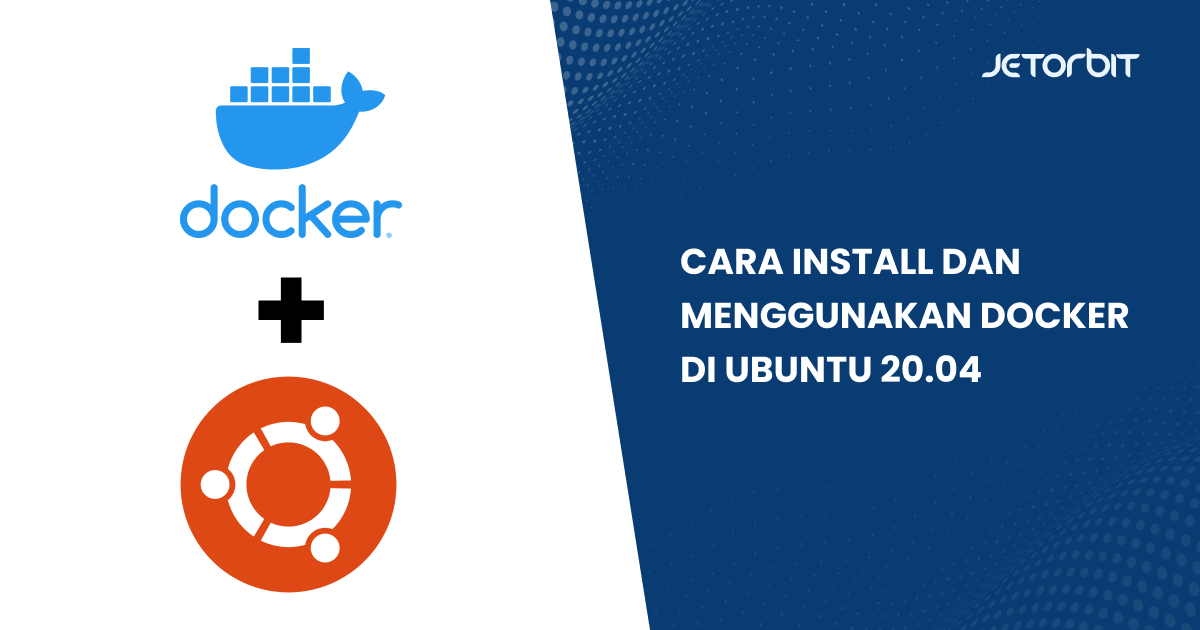Ingin tahu lebih detail terkait bagaimana cara install dan menggunakan Docker? Okay, langsung simak yuk sampai kelar Cara Install dan Menggunakan Docker di Ubuntu 20.04
Apa Itu Docker?
Docker adalah sebuah aplikasi yang bersifat open source yang berfungsi sebagai wadah atau container untuk mengepak atau memasukkan sebuah software secara lengkap beserta semua hal lainnya yang dibutuhkan oleh software tersebut dapat berfungsi.
Pengaturan software beserta file atau hal pendukung lainnya akan menjadi sebuah Image (istilah yang diberikan oleh docker). Lalu, sebuah instan dari Image tersebut kemudian disebut Container.
Kali ini akan dibahas mengenai cara install dan menggunakan Docker di Ubuntu 20.04.
Persyaratan
Terdapat beberapa persyaratan sebelum melakukan instalasi.
- Memiliki VPS yang aktif dengan OS Ubuntu 20.04.
- Memiliki akses root.
Cara Install dan Menggunakan Docker di Ubuntu 20.04
Berikut ini cara install dan menggunakan Docker di Ubuntu 20.04 yang bisa kalian terapkan.
Update Server
Login sebagai root ke server dan update server untuk memastikan packages-nya sudah up-to-date.
$ apt-get update -y
$ reboot
Install beberapa packages yang dibutuhkan.
$ apt-get install nano perl wget curl -y
Install Firewall
Sebelum kalian memulai, perlu instalasi Firewall supaya lebih secure. Pada Firewall ini menggunakan CSF (ConfigServer Security & Firewall). Instalasinya dengan perintah di bawah ini:
$ cd /usr/src/
$ wget https://download.configserver.com/csf.tgz
$ tar -xzf csf.tgz
$ cd csf/
$ sh install.sh
Pada konfigurasi CSF rubah “make TESTING=’1’ menjadi 0”.
$ nano /etc/csf/csf.conf
Jika sudah, save dan exit.
Lalu restart CSF supaya reload konfigurasi yang ter-update.
$ csf -r
Install Docker
Docker Package tersedia di official ubuntu repository yang mungkin tidak up-to-date atau tidak latest. Nah, untuk mendapatkan versi yang latest, perlu install Docker melalui official Docker repository.
Add GPG key pada official Docker repository ke server kalian.
$ curl -fsSL https://download.docker.com/linux/ubuntu/gpg | sudo apt-key add –
Add Docker repository ke APT source.
$ add-apt-repository “deb [arch=amd64] https://download.docker.com/linux/ubuntu focal stable”
Pastikan kalian install Docker melalui Ubuntu repo.
$ apt-cache policy docker-ce
Output:
docker-ce:
Installed: (none)
Candidate: 5:20.10.22~3-0~ubuntu-focal
Version table:
5:20.10.22~3-0~ubuntu-focal 500
500 https://download.docker.com/linux/ubuntu focal/stable amd64 Packages
Pastikan bahwa docker-ce tidak terinstall karena instalasinya nanti melalui Docker repository untuk Ubuntu 20.04 (focal).
Install Docker
$ apt-get install docker-ce -y
Start dan enable on-boot docker service.
$ systemctl start docker
$ systemctl enable docker
Cek status docker
$ systemctl status docker
docker.service – Docker Application Container Engine
Loaded: loaded (/lib/systemd/system/docker.service; enabled; vendor preset: enabled)
Active: active (running) since Wed 2022-12-21 07:00:54 UTC; 16min ago
TriggeredBy: ● docker.socket
Docs: https://docs.docker.com
Main PID: 4700 (dockerd)
Tasks: 8
Memory: 21.1M
CGroup: /system.slice/docker.service
└─4700 /usr/bin/dockerd -H fd:// –containerd=/run/containerd/containerd.sock
Menggunakan Docker Command
Menggunakan Docker terdiri dari meneruskan rangkaian opsi dan perintah yang diikuti dengan argumen, contoh syntaxnya:
$ docker [option] [command] [arguments]
Untuk melihat subcommands yang tersedia:
$ docker
Output:
Commands:
attach Attach local standard input, output, and error streams to a running container
build Build an image from a Dockerfile
commit Create a new image from a container’s changes
cp Copy files/folders between a container and the local filesystem
create Create a new container
diff Inspect changes to files or directories on a container’s filesystem
events Get real time events from the server
exec Run a command in a running container
export Export a container’s filesystem as a tar archive
history Show the history of an image
images List images
import Import the contents from a tarball to create a filesystem image
info Display system-wide information
inspect Return low-level information on Docker objects
kill Kill one or more running containers
load Load an image from a tar archive or STDIN
login Log in to a Docker registry
logout Log out from a Docker registry
logs Fetch the logs of a container
pause Pause all processes within one or more containers
port List port mappings or a specific mapping for the container
ps List containers
pull Pull an image or a repository from a registry
push Push an image or a repository to a registry
rename Rename a container
restart Restart one or more containers
rm Remove one or more containers
rmi Remove one or more images
run Run a command in a new container
save Save one or more images to a tar archive (streamed to STDOUT by default)
search Search the Docker Hub for images
start Start one or more stopped containers
stats Display a live stream of container(s) resource usage statistics
stop Stop one or more running containers
tag Create a tag TARGET_IMAGE that refers to SOURCE_IMAGE
top Display the running processes of a container
unpause Unpause all processes within one or more containers
update Update configuration of one or more containers
version Show the Docker version information
wait Block until one or more containers stop, then print their exit codes
Untuk mengetahui informasi Docker pada server.
$ docker info
Menggunakan Docker Images
Docker containers dibuat dari image docker. Secara default, Docker mengambil image ini dari Docker Hub, sebuah registry Docker yang dikelola oleh Docker, perusahaan dibalik proyek Docker.
Siapapun dapat menghosting docker images pada Docker Hub, sehingga sebagian besar aplikasi dan distribusi Linux yang diperlukan akan memiliki images di sana.
Untuk mengecek akses dan download images dari Docker Hub menggunakan perintah di bawah ini.
$ docker run hello-world
Output:
Unable to find image ‘hello-world:latest’ locally
latest: Pulling from library/hello-world
2db29710123e: Pull complete
Digest: sha256:c77be1d3a47d0caf71a82dd893ee61ce01f32fc758031a6ec4cf1389248bb833
Status: Downloaded newer image for hello-world:latest
Hello from Docker!
This message shows that your installation appears to be working correctly.
…
Docker awalnya tidak dapat menemukan images dari hello-world secara lokal sehingga Docker mengambil atau mengunduh images nya dari Docker Hub, yang merupakan repository default. Setelah images di-download, Docker membuat kontainer dari images tersebut dan aplikasi nya berada dalam container.
Selain itu, bisa juga mencari images yang tersedia di Docker Hub dengan menggunakan perintah docker dengan sub perintah search. Misalnya, untuk mencari image nginx, seperti berikut.
$ docker search nginx
Output:
Pada kolom OFFICIAL, OK menunjukkan image yang dibuat dan didukung oleh perusahaan dibalik project tersebut. Setelah kalian mengidentifikasi image yang akan digunakan, kalian bisa download menggunakan sub perintah pull.
$ docker pull nginx
Output:
Using default tag: latest
latest: Pulling from library/nginx
025c56f98b67: Pull complete
ec0f5d052824: Pull complete
cc9fb8360807: Pull complete
defc9ba04d7c: Pull complete
885556963dad: Pull complete
f12443e5c9f7: Pull complete
Digest: sha256:ff5d8d8389474b6ad895ec6089e926711ce2af5939860488938f394298eedea9
Status: Downloaded newer image for nginx:latest
docker.io/library/nginx:latest
Setelah image di-download, bisa menjalankan container menggunakan images yang sebelumnya di-download dengan sub perintah run.
Seperti yang dilihat sebelumnya pada contoh hello-world, jika image belum di-download saat docker dijalankan dengan sub perintah run, Docker client akan download image-nya lebih dulu lalu menjalankan container dengan menggunakannya.
$ docker images
Output:
REPOSITORY TAG IMAGE ID CREATED SIZE
nginx latest 3964ce7b8458 7 days ago 142MB
hello-world latest feb5d9fea6a5 15 months ago 13.3kB
Nah, jadi, apabila kalian mengikuti artikel ini secara keseluruhan, artinya kalian sudah berhasil dan mengetahui cara install dan menggunakan Docker di Ubuntu 20.04.
Semoga bermanfaat dan tunggu info-info menarik lainnya dari kami, ya 🙂










Leave a Comment